火星 ALPO-Japan Latest

Mars Image 2007/07/08(UT)
Damian Peach,Bruce Kingsley,David Arditti
D.Peach,B.Kingsley,D.Arditti
解説(安達)
D.Peach氏からオーロラシヌス(Aurorae Sinus;50W,-10)付近の画像が報告されてきた。ダストストームによって、模様の見え方が大きく変化し、肉眼観測だったら、オーロラシヌスがきっとソリスに見えたことと思われる。ソリス(Solis lacus;90W,-25)はすっかり見えなくなってしまった。最も明るいダストストームはネクター(Nectar;70W;-23)を中心とした位置にある。さらにその南側のデルフィーニ(Delphini Portus;70W,-35)付近にも明るさの低いダストストームがあるかもしれない。ここは、本来は暗い部分だが、明るく記録されている。また、西のほうではダエダリア(Daedaria;120W,-30)付近まで広がっている。
反対に、バエティス(Baetis;60W,-3)が暗くなり、大きな暗部として記録されている。火星の視直径が大きくなると、分離して見える可能性もあるが、前シーズンとは違った姿になった。また、そのすぐ東側のイアムナエ(Iamunae;50W,0)もかなり大きくなったようだ。
南極冠ははっきりしない。ダストストームに覆われているとおもわれる。しかし、D.Peach
氏の画像では白く写っている。南極冠はダストストームに覆われ、その上空を霧に覆われてると考えるの適当だろう。(reported by 3 observers)
The image near Aurorae Sinus (50W,-10) has been reported from Damian Peach. How where a pattern is in sight is changing with duststorm a lot. It seems that visual observation probably had Aurorae visible to Solis Lacus. Solis lacus (90W,-25) has disappeared completely. Brightest dust storm is in the position centering on Nectar (70W-23). Furthermore, duststorm with low brightness may be also near Delphini Portus (70W,-35) on the south. Although it is originally a dark portion, it is recorded here brightly. Moreover, west one spreads out to near Daedaria (120W,-30).
On the contrary, Baetis (60W,-3) becomes dark and is recorded as a big dark section.
may dissociate and be visible if the apparent diameter of Mars becomes large. It became a figure different from a last season here. It seems that the Iamunae (50W,0) which is in the east side immediately also became quite large. SPC does not clarify. It seems that it is covered with duststorm. However, by the picture of D.Peach, it is reflected white. thinking that SPC is covered with duststorm and the sky is covered with fog -- it will be suitable. (reported by 3 observers)
FROM Makoto Adachi
-------------------------------------------------------------------------------------
|
Damian Peach (350mm Celestron SCT) |
Here are some images from this morning. Pretty decent seeing for the low altitude. Some extensive dust obscuration across Solis Lacus extending across Claritas into Daedelia. Aurorae Sinus upto Protei Regio looks very dark. Argyre looks fairly bright,(possibly dust?)
Below are links to colour and mono imagery. Also a simulated image of the time to show what the Planet "should" look like.
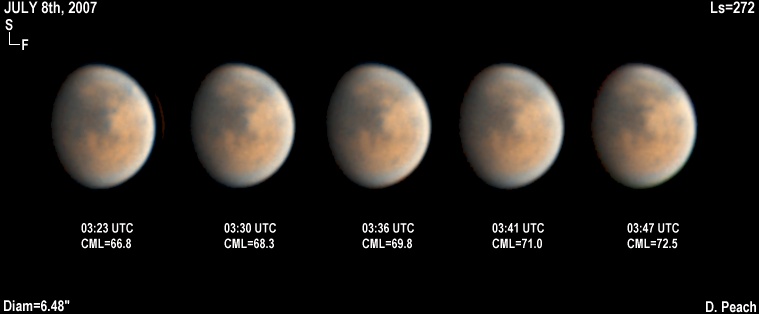
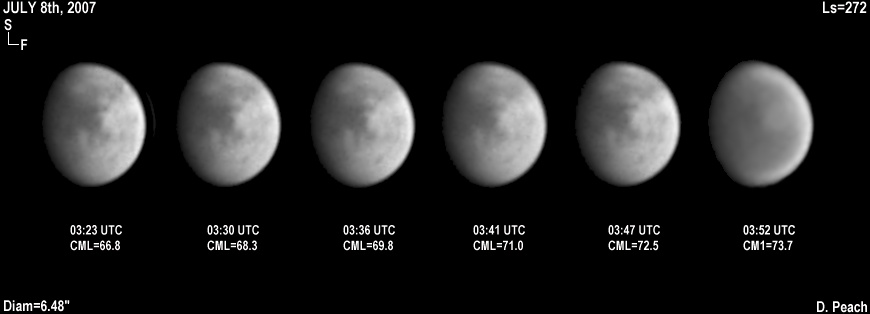
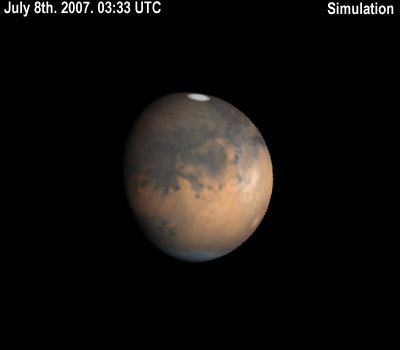
[Damian Peach: Loudwater,Buckinghamshire,United Kingdom]
|
Bruce Kingsley(280mm SCT) |
not alone the other night.One of those increasingly rare nights of clarity
but unfortunately very poor seeing from my position.
Still,having waited up,prepared,and collimated,it had to be done.
My first Mars image for this apperition.It shook like a jelly in a fish
tank,but some results can be seen.
Onwards and upwards
ps : Is it possible that one of the observers has bottled some really good
seeing conditions from an island such as Barbados,and then releases them
about his telescope just prior to imaging ?
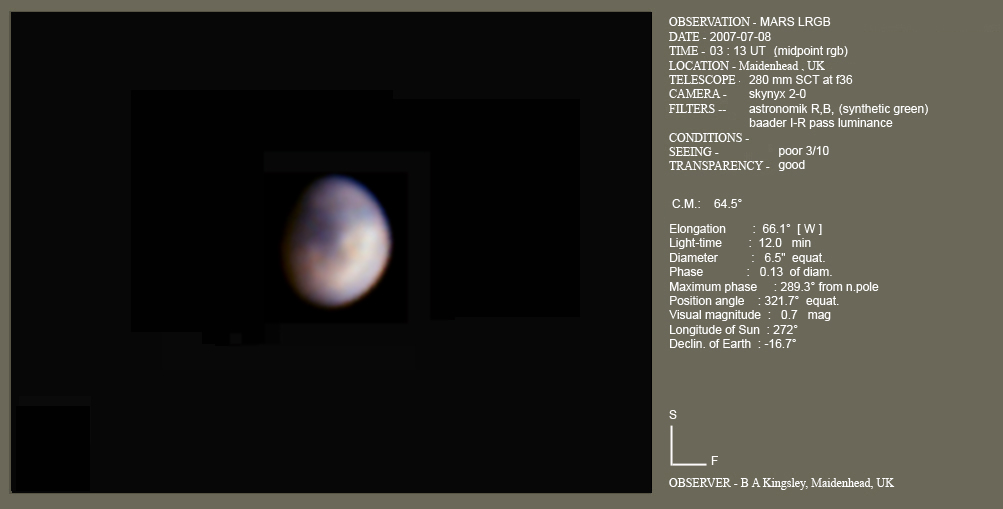 [Bruce Kingsley: Maidenhead United Kingdom]
[Bruce Kingsley: Maidenhead United Kingdom]
|
David Arditti (250mm Dall-Kirkham Cassegrain) |
Some attempts at Mars from July 08, though you will probably have seen some
better ones by now.
I am getting the "dark ring" effect very severely on these. Anyone know how to
combat it? Or is it just bad seeing?
Anyway, the dust is discernible if you know how the planet "should" look -
thanks Damian for the simulation.
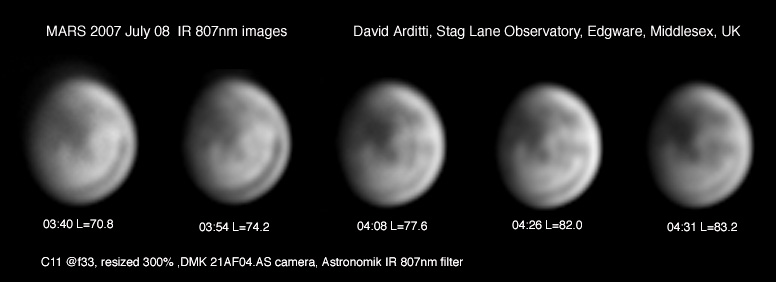
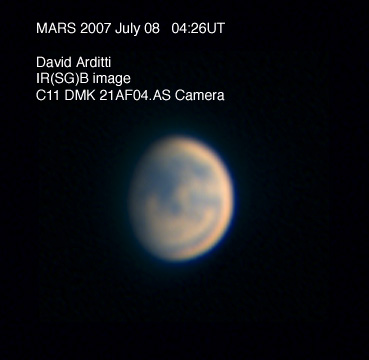 [David Arditti: Edgware Middlesex HA8 5LW: United Kingdom]
[David Arditti: Edgware Middlesex HA8 5LW: United Kingdom]





[Bruce Kingsley: Maidenhead United Kingdom]

[David Arditti: Edgware Middlesex HA8 5LW: United Kingdom]
 ALPO-Japan Latest
ALPO-Japan Latest

 Mars Section
Mars Section